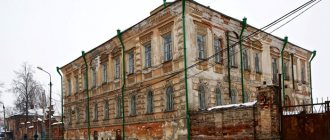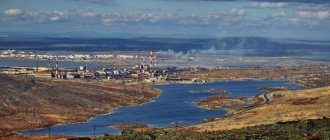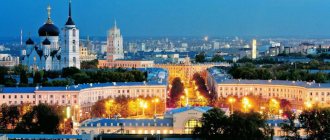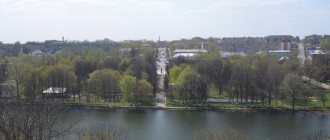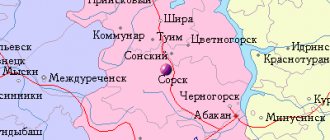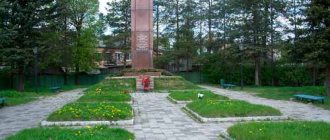History of conferring the honorary title “City of Military Glory”
Kozelsk found itself in the direction of advance of the fascist Army Group Center, which delivered the main attacks along the Bobruisk, Medyn, Maloyaroslavets highway (north of the Kozelsky region) with forces of 4A and 4 tank groups;
in the direction of Glukhov, Orel, Tula (south of the Kozelsky region) by the forces of the 2nd Tank Army. It was captured by the Germans on October 8, 1941. During the Great Patriotic War, Kozelsk played an important role in the defense of our country and especially in the defense of the capital: here, during the Kaluga offensive operation, large enemy forces were pinned down, which was of strategic importance for the counter-offensive near Moscow.
Liberated by the 1st Guards Cavalry Corps on December 28, 1941 during the Belevsko-Kozel operation of the Battle of Moscow. The city was severely destroyed.
Today, the missile division stationed in Kozelsk reliably protects the peaceful life of citizens and ensures the security of our country.
Kozelsk in 2009 received the honorary title “City of Military Glory” of Russia - “for the courage, fortitude and mass heroism shown by the defenders of the cities in the struggle for the freedom and independence of the Fatherland” during the Great Patriotic War.
Notes[ | ]
- ↑ 12
The permanent population of the Russian Federation by municipalities as of January 1, 2021 (Russian). Date accessed: April 27, 2021. Archived May 2, 2021. - Law of the Kaluga Region of December 28, 2004 No. 7-OZ “On establishing the boundaries of municipalities located on the territory of the administrative-territorial units “Babyninsky District”, “Borovsky District”, “Dzerzhinsky District”, “Zhizdrinsky District”, “Zhukovsky District” , “Iznoskovsky district”, “Kozelsky district”, “Maloyaroslavetsky district”, “Mosalsky district”, “Ferzikovsky district”, “Khvastovichsky district”, “City of Kaluga”, “City of Obninsk”, and giving them the status of an urban settlement, rural settlement , urban district, municipal district"
- Variants of names of residents on the website Culture of Written Speech (Retrieved July 6, 2009)
- Kozelsk // Encyclopedic Dictionary of Brockhaus and Efron: in 86 volumes (82 volumes and 4 additional). - St. Petersburg, 1890-1907.
- Order of the People's Commissar of Internal Affairs of the USSR of September 19, 1939 No. 0308
- Nicholas Bethell.
Katyn 1940
(unspecified)
(inaccessible link). // Continent, 2012, No. 151. Date of access: August 5, 2013. Archived October 15, 2014. - Document No. 76 // Katyn. Prisoners of an undeclared war. Documents and materials / Editorial board: N. S. Lebedeva (responsible author) and others - M.: MF "Democracy", 1999. - ISBN 5-89511-002-9
- The President signed decrees conferring the honorary title “City of Military Glory” on the cities of Arkhangelsk, Kozelsk and
Pskov . // Kremlin.ru (December 8, 2009). Access date: August 13, 2010. Archived August 21, 2011. - Materials for the geography and statistics of Russia, collected by officers of the General Staff. Kaluga province / comp. M. Poprocki. - SPb.: Type. E. Weimar, 1864. - 563 p.
- Kaluga province ... according to information from 1859 / Edited. N. Stieglitz. - St. Petersburg. : ed. Center. stat. com. Min. internal Affairs, 1863. - (Lists of populated places of the Russian Empire, compiled and published by the Central Statistical Committee of the Ministry of Internal Affairs; 1861-1885).
- Memorial book and address-calendar of the Kaluga province for 1869. — Kaluga: Kaluzh. lips stat. com., 1869. - 273 p.
- Populated areas of the Russian Empire with 500 or more inhabitants, indicating the total population present in them and the number of inhabitants of the prevailing religions, according to the first general population census of 1897 / preface: N. Troinitsky. - St. Petersburg: printing house "Public Benefit", 1905. - P. 75−78.
- List of populated places in Kaluga province / Ed. F. F. Kadobnova. — Kaluga: Kaluzh. lips stat. com., 1914.
- Preliminary results of the 1920 All-Russian population census for the Kaluga province / Preface by the head of the demography department of the Gubstatburo F. Kadobnov. — Kaluga: State Publishing House. Kaluga branch, 1921. - 19 p.
- Territorial and administrative division of the USSR on January 1, 1926. - M.: Publishing house GUKH NKVD, 1926. - 284 p.
- Administrative-territorial division of the USSR and a list of the most important settlements with a chronological list of decisions on changing the boundaries of provinces, regions and republics. — Ed. 8th. - M.: Publishing house Nar. Commissariat of Internal Affairs, 1929. - 320 p.
- Administrative-territorial division of the USSR (as of January 1, 1931). I. RSFSR (undefined)
. Access date: August 19, 2013. Archived August 19, 2013. - All-Union Population Census of 1939. The size of the urban population of the USSR by urban settlements and intra-city areas (unspecified)
. Retrieved November 30, 2013. Archived November 30, 2013. - All-Union Population Census of 1959. The size of the urban population of the RSFSR, its territorial units, urban settlements and urban areas by gender (Russian). Demoscope Weekly. Access date: September 25, 2013. Archived April 28, 2013.
- All-Union Population Census of 1970 The size of the urban population of the RSFSR, its territorial units, urban settlements and urban areas by gender. (Russian). Demoscope Weekly. Access date: September 25, 2013. Archived April 28, 2013.
- All-Union Population Census of 1979 The size of the urban population of the RSFSR, its territorial units, urban settlements and urban areas by gender. (Russian). Demoscope Weekly. Access date: September 25, 2013. Archived April 28, 2013.
- All-Union population census of 1989. Urban population (undefined)
. Archived from the original on August 22, 2011. - ↑ 1 2 3 4 5 6 7 8 9 10 People
's encyclopedia “My City”.
Kozelsk (undefined)
. Retrieved November 20, 2013. Archived November 20, 2013. - All-Russian population census 2002. Volume. 1, table 4. Population of Russia, federal districts, constituent entities of the Russian Federation, districts, urban settlements, rural settlements - regional centers and rural settlements with a population of 3 thousand or more (unspecified)
. Archived from the original on February 3, 2012. - The size of the permanent population of the Russian Federation by cities, urban settlements and regions as of January 1, 2009 (unspecified)
. Retrieved January 2, 2014. Archived January 2, 2014. - All-Russian population census 2010. Number and distribution of the population of the Kaluga region (volume 1) (undefined)
. Access date: July 14, 2021. - Population of the Russian Federation by municipalities. Table 35. Estimated resident population as of January 1, 2012 (unspecified)
. Retrieved May 31, 2014. Archived May 31, 2014. - Population of the Russian Federation by municipalities as of January 1, 2013. - M.: Federal State Statistics Service Rosstat, 2013. - 528 p. (Table 33. Population of urban districts, municipal districts, urban and rural settlements, urban settlements, rural settlements) (undefined)
. Retrieved November 16, 2013. Archived November 16, 2013. - Table 33. Population of the Russian Federation by municipalities as of January 1, 2014 (unspecified)
. Access date: August 2, 2014. Archived August 2, 2014. - Population of the Russian Federation by municipalities as of January 1, 2015 (unspecified)
. Access date: August 6, 2015. Archived August 6, 2015. - Population of the Russian Federation by municipalities as of January 1, 2021 (Russian) (October 5, 2018). Date accessed: May 15, 2021. Archived May 8, 2021.
- Population of the Russian Federation by municipalities as of January 1, 2021 (Russian) (July 31, 2017). Retrieved July 31, 2021. Archived July 31, 2021.
- Population of the Russian Federation by municipalities as of January 1, 2021 (Russian). Retrieved July 25, 2018. Archived July 26, 2021.
- Population of the Russian Federation by municipalities as of January 1, 2021 (Russian). Date accessed: July 31, 2019. Archived May 2, 2021.
- Population of the Russian Federation by municipalities as of January 1, 2021 (Russian). Date accessed: October 17, 2021. Archived October 17, 2021.
- taking into account the cities of Crimea
- https://rosstat.gov.ru/storage/mediabank/bul_Chislen_nasel_MO-01-01-2021.rar Population of the Russian Federation by municipalities as of January 1, 2021 (1.85 Mb, 07/30/2021)
- ↑ 1 2 Kalantarova, Olga;
Makhmutova, Olga. It’s a pleasure to work in Kozelsk
(undefined)
.
TASS
(October 5, 2017). Access date: April 29, 2021. - “Optina Spring” was postponed to autumn (unspecified)
. "National Accent" (May 14, 2020). Date accessed: May 23, 2021. - Singers from six countries came to Kozelsk for the 11th competition “Optina Spring” (unspecified)
. "Rossiyskaya Gazeta" (May 23, 2021). Date accessed: May 23, 2021. - The Bank of Russia issues commemorative coins made of precious and base metals
The city during the Second World War
On June 22, 1941, the Great Patriotic War began. The men of the city went to the front. Only children, old people and women remained in Kozelsk. The fighting was approaching the city. First, refugees from the western regions of the country came in a stream through Kozelsk, then defeated, retreating units emerging from encirclement. And on October 8, 1941, German troops of Army Group Center entered the city. However, the occupation did not last long. Already on December 28, 1941, as a result of the Belevsko-Kozel operation, the city was liberated by the cavalry group of General Belov.
Perhaps due to the fact that during this short period the city was occupied only by army units performing specific combat missions, during the eighty days of occupation Kozelsk did not experience the atrocities that the Nazis committed in other territories they occupied.
Population[ | ]
| Population | ||||||||
| 1857[9] | 1859[10] | 1868[11] | 1897[12] | 1913[13] | 1920[14] | 1923[15] | 1926[16] | 1931[17] |
| 7953 | ↘7530 | ↘7325 | ↘5619 | ↗6358 | ↘3957 | ↗4911 | ↗5707 | ↗5793 |
| 1939[18] | 1959[19] | 1970[20] | 1979[21] | 1989[22] | 1992[23] | 1994[23] | 1996[23] | 1998[23] |
| ↗8182 | ↗12 114 | ↗13 026 | ↗19 789 | ↘19 735 | ↗19 900 | ↗20 200 | ↗20 600 | ↗20 800 |
| 2001[23] | 2002[24] | 2003[23] | 2005[23] | 2006[23] | 2007[23] | 2009[25] | 2010[26] | 2011[23] |
| →20 800 | ↘19 907 | ↘19 900 | ↘19 500 | ↘19 300 | ↘19 100 | ↘18 500 | ↘18 245 | ↘18 200 |
| 2012[27] | 2013[28] | 2014[29] | 2015[30] | 2016[31] | 2017[32] | 2018[33] | 2019[34] | 2020[35] |
| ↘17 871 | ↘17 312 | ↘16 694 | ↘16 273 | ↘16 045 | ↗16 370 | ↗16 443 | ↘16 389 | ↗16 427 |
| 2021[1] | ||||||||
| ↘16 329 | ||||||||
As of January 1, 2021, in terms of population, the city was in 742nd place out of 1,116[36]cities of the Russian Federation[37].
Merits of the city in the military history of Russia
Kozelsk is an ancient Russian city. The history of the city of Kozelsk begins with the first mention of it in the Novgorod Chronicle. This mention is dated 1146. In 1238, Kozelsk became widely known. This year the Tatars came to Rus'. The Horde army led by Khan Batu approached the city. Local residents decided to give the Horde a worthy rebuff. The city of Kozelsk held a heroic defense for seven whole weeks. When the Tatars finally broke through the city walls and broke into Kozelsk, Batu ordered the troops not to leave anyone alive in the city. Kozelsk drowned in blood. They say that since then the Horde people have not spoken the name of the city; Kozelsk was simply simply called the “Evil City”. All that remains of Kozelsk are ruins.
In the 15th century, to protect Russian lands from the Lithuanians, Crimean Tatars and Horde, a new wooden fortress was erected. Kozelsk is a border town that has more than once become an impenetrable barrier for the enemy. By the 16th century, Kozelsk was a large city with a population of 15,000 people.
The years of the Time of Troubles did not spare Kozelsk. In 1613, there were about 1,000 citizens in the city.
In 1776, Kozelsk received the status of a county town. Kozelsk acquired its own coat of arms, which symbolically depicts the feat of the townspeople during Batu’s invasion. In the 19th century there were several sailing factories in Kozelsk. Sailing production was the pride of the city. The main attractions of Kozelsk are the Orthodox monasteries: the Holy Vvedenskaya Optina Hermitage and the Shamordinskaya Kazan Holy Ambrosian Hermitage.
Kozelsk met the beginning of the 20th century as a provincial town. There were no large industrial enterprises, trade in Kozelsk did not flourish, cultural life left much to be desired.
"Ogonyok" visited the small homeland of Nikolai Karamzin
The official part is coming to an end, but here the guide, local historian and secretary of the Kozelsky Society of Russian Literary People Galina Gorokhova takes the floor:
“It was here, in Kozelsk, that the principle of “die but not surrender” was born, which later passed through the entire Russian history,” she instructs schoolchildren. “When the enemy comes, we must be united.” After all, we still remain a city of warriors, because in our forests we have part of the nuclear shield of the Motherland.
It’s true, the Strategic Missile Forces division is based in Kozelsk. Launch silos are hidden in the surrounding thickets; in the city itself there is a headquarters, a parade ground, an army cultural center, economic services and a huge military camp. The division is one of two city-forming enterprises. The second is located a few kilometers from the city of Optina Pustyn. That's why there are a lot of out-of-towners in Kozelsk. Some came to serve in the division, others came to pray in the desert. Galina Eduardovna and her husband are from the last category, they are originally from Moscow. It just so happened that all Kozel local historians are not from here.
What would Kozelsk be without goats?
Photo: Dmitry Lebedev, Kommersant
In the end, Galina Gorokhova moves from high matters to low ones. It turns out that the residents of Deshovoki have been looking for treasure in the vicinity of the village of Batu for many centuries. Allegedly, during the siege of Kozelsk, the khan’s daughter caught a cold and died. They buried her here along with the golden boat.
“You definitely have to look for the treasure on Easter night.” Not to go to church, but to the mound! - the speaker says. - Then a cave opens there, there are some kind of witch frogs in it, and if something is done incorrectly, the treasure hunter dies. Grandmothers tell this from generation to generation like a fairy tale. But our women told me: it may be a fairy tale, but this guy died, another died.
The meeting is over, in just a minute the schoolchildren get dressed and disappear through the door. Workers of the Deshov cultural center sit down for tea and remember the local treasure hunters:
“Indeed, my mother-in-law told me that her relative was also digging and died.
“And I heard from our former director: her husband kept digging the ground, looking for treasure, and then he died.”
The most significant military events associated with the city
The advance of the 10th Army in the Kozelsk direction was complicated by the exceptionally high activity of enemy aviation. She intensively bombed and shelled our troops. Losses inflicted by enemy aircraft were very sensitive. So, in just one day, the 324th Infantry Division lost 80 people killed and many wounded from enemy air raids. There were no enemy field units on the approaches to Kozelsk. The forward detachments of the 324th and 239th Rifle Divisions encountered some resistance in the forest southeast of Kozelsk. These were the enemy's railway, engineering and security units. They tried to slow down our progress. The fascist German units retreating to Kozelsk towards Likhvin were intercepted by the cavalry of General Belov and partly destroyed, and partly thrown back to the formations of the 10th Army. Kozelsk was taken.
Merits of the city's rear
In the summer of 1941, on the territory of the Cherepetsky district of the Tula region, under the direct leadership of the local head of the state security department M. Shcherbakov, the arrangement of a hidden partisan base was organized. It was intended to be used in the event of enemy occupation of the territory.
The Pavlovsk forests were chosen as the location for the base.
Dmitry Aleksandrovich Bessonov, a patrolman of the Pavlovsk forestry, and his minor sons Nikolai and Georgy, 10 and 12 years old, took active help in setting up the base, and later in the partisan struggle. Thus, the entire Bessonov family was a partisan. At the Pavlovsky cordon, in the house of forester Bessonov, the detachment’s headquarters was initially based. Later, his house was used for meetings of signalmen, as well as for recreation of groups of partisans. And they always received from the Bessonovs not only a roof over their heads and hot food, but also important information about the enemy.
The partisan detachment was called “Advanced”. The detachment was headed by the assistant detective officer of the Cherepetsky district police department of the NKVD, police sergeant Dmitry Timofeevich Teterchev, who previously headed the fighter battalion of the Cherepetsky district.
The detachment’s tasks included controlling roads in the Kozelsk-Belev section along the Przemysl-Likhvin line. The detachment's combat operations took place in this area. But the detachment waged a more active guerrilla war in the base area.
The detachment began active combat operations on October 11, 1941, destroying up to 20 enemy soldiers and officers and damaging 12 cars and 5 motorcycles.
On October 15, partisans destroyed the communication line along the railway from Kozelsk to Myshbor, cutting it every kilometer.
On October 30, 1941, the detachment paralyzed traffic on the railway from Kozelsk to the station for a day. Mousebor. In addition, at the Myshbor station, the partisans burned two Nazi special communications carriages.
Throughout the entire period of the detachment's action, the railway in the section from Kozelsk to Myshbor was constantly exposed to partisans. Movement along it was completely paralyzed. In addition to explosives, railroad tools were also used to dismantle tracks. Locomotives were fired upon and disabled, and security at the station was destroyed. Combat operations on the railway were carried out daily.
Transport[ | ]
- Single-track non-electrified line Smolensk - Tula with a branch to Belyov. Railway stations Kozelsk and Tupik.
- Highway to Kaluga
- Automobile access to the M3 "Ukraine" highway
Intercity buses depart daily from the city bus station to Kaluga, Moscow and once every two days to Voronezh. The city is also connected by suburban bus service to some settlements in the region and the neighboring regional center of Sukhinichi.
Intra-city car traffic is small, only three intersections are equipped with traffic lights[38].
Military units and formations formed from the city population
1941, July. At the edge of the forest east of Kozelsk (forest in the area of the Mechanical Plant) a military camp was set up. Here, a division was formed from military reserves and conscripts from Kozelsky and nearby areas (Peremyshl, Sukhinichesky, Ulyanovsk). The commander of the division during the period of its formation was the chairman of the regional council of Osoaviakhim, Mikhail Vasilyevich Kuleshov, and the commissar, Alexey Grigorievich Salin, was the chief agronomist of the Red Combine state farm. After its formation, the division went to the Tula camps, where it joined the reserve rifle division. M.V. Kuleshov died near Volokolamsk defending Moscow.
